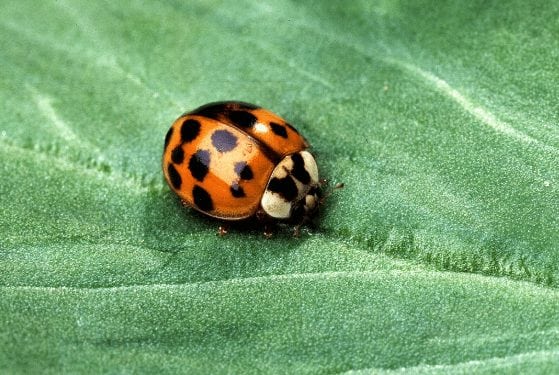Your Cart is Empty
Free Shipping on Orders Over $40
Free Shipping on Orders Over $40
Free Shipping on Orders Over $40
Eliminating the beetles once they are indoors can be done with a combination of aerosol sprays and sticky traps. Our Harris Lady Beetle Killer is the perfect solution. The Asian lady beetle will often come to windows during the day, and can be treated with an aerosol and captured in traps at this location. It is just that easy to get rid of Asian Lady Beetles.
Preventing large aggregations begins with spraying insecticides, such as Harris Lady Beetle Killer, on the house siding where the beetles start to gather. This may encourage them to leave. Re-application of the liquid insecticide may be necessary because the residual activity will be reduced with exposure to the sun. Treating around the doors and windows may help to keep them from coming indoors along these routes. Applying insecticide directly to the beetles will be the most effective method of control.
Ladybugs occupy an interesting place in the pest world. They are generally considered very beneficial bugs because they eat so many detrimental insects. Many cultures even consider ladybugs to be a sign of good luck. Some species, however, can be quite a nuisance when they try to overwinter inside homes. Keeping them in the garden, and out of your home can seem like a daunting task, but there are prevention and control methods available to help you achieve this. Let’s take a closer look at ladybugs in this ultimate guide.

Nearly everyone knows about the friendly little red insects with black spots that spend their days in gardens, but it seems that everyone has a different name for them. In the United States, they are most commonly known as ladybugs. In most of Europe, including Britain, they are known as ladybirds or ladybird beetles. Most entomologists actually prefer the term lady beetles. No matter what you call them, these insects are an important part of the ecosystem. Ladybugs are part of the beetle family. There are over 6,000 different species in the world, and they vary greatly in color <1>. Most are orange, yellow, or red with black spots or stripes and white accents. The specific combination of these colors helps to give a clue to what species it is. Ladybugs range in size from .8-18 mm long. They are domed insects that are round or oval-shaped. Ladybugs fly using their wings, have six short black legs, and have short, clubbed antennae.

Nine Spotted Ladybug


There are many tips and tricks that will help you get rid of ladybugs around your home, but like most things, prevention is always the best place to start. Here are some things you can do to protect your home.
Top on the list of effective strategies is sealing the exterior of your home to prevent entry. Use caulking to seal small cracks and gaps around the outside of your home. If you have larger holes, especially around plumbing or electrical fixtures, fill them will expandable spray foam. Also fix all screens and weather stripping around doors and windows.
Every few months, you can spray around the perimeter of your home with a synthetic pyrethroid insecticide. These residual treatments help to keep out all kinds of insects, including ladybugs. It is especially important that you spray in early fall and early spring on the south and southwest exteriors to keep the lady beetles from congregating around your home. Also pay attention to entry points like attic vents, around windows, near doors, and around eaves.Harris Asian Lady Beetle and Box Elder Bug Killer is a great option.
There are a variety of traps that can be used to get rid of lady beetles. Regular sticky traps in windows help to monitor insect populations and can get rid of a percentage of the population of the ladybugs that are in your home. If you are seeing large numbers of them, you can also make your own trap using a nylon fastened over the end of a vacuum hose with a rubber band. After you suck up the insects, you have the option of letting them go back out in the garden where they belong.
Insecticidal dusts are good for many different types of bugs and are great for hard to reach areas like around light switch plates, electrical outlets, and plumbing openings. Dusts can last for up to 8 months.
Indoors, you can use aerosols and sprays that will kill on contact. You can spray directly on the insects, or you can use an applicator tip to get into cracks and crevices where they may be hiding.